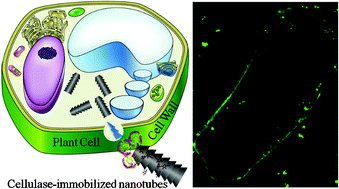 Carbon nanotubes that look like cups stacked on top of each other have been functionalized with cellulase enzyme to enable them to penetrate inside cells through induced nanoholes without damaging the entire plant cell wall.
Carbon nanotubes that look like cups stacked on top of each other have been functionalized with cellulase enzyme to enable them to penetrate inside cells through induced nanoholes without damaging the entire plant cell wall.
Plant cell wall is a unique barrier made up of cellulosic materials which prevent the passage of macromolecules inside the cells. Traditionally, when studying plant biology, scientists strip away the cell wall using cellulase (an enzyme that causes cellulose hydrolysis) or other chemical treatments. The latter procedures to disorganize the cell walls may affect the cell viability or the cell’s capability to divide.
Scientists at Nagoya University in Japan, have developed a clever way to functionalize cup-stacked carbon nanotubes functionalized on their tips and walls with cellulase. The immobilized cellulase is proposed to induce local lesions in the cell wall, through which carbon nanotubes can transport into the interior of the cell.
The authors believe that this new method could open a lot of opportunities for studying plant cell genetics or plant diseases.
Download the full article for free by simply registering here.
Introducing carbon nanotubes into living walled plant cells through cellulase-induced nanoholes
Maged F. Serag, Noritada Kaji, Manabu Tokeshi and Yoshinobu Baba
RSC Adv., 2012, Advance Article, DOI: 10.1039/C1RA00760B, Communication










